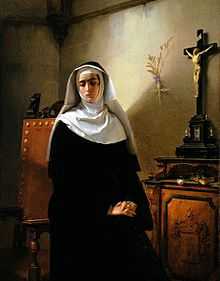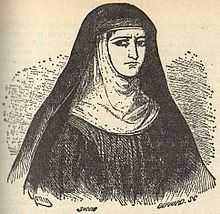The Nun of Monza
| Marianna de Leyva y Marino | |
|---|---|
 La monaca di Monza, painting by Giuseppe Molteni | |
| Born |
Marianna de Leyva y Marino 1575 Milan, Italy |
| Died |
1650 Milan, Italy |
| Nationality | Italian |
| Other names | The Nun of Monza, Virginia Maria |
| Occupation | Nun |
| Known for |
Scandal in 1607 Character in the novel 'The Betrothed' by Alessandro Manzoni |
Sister Virginia Maria (born Marianna de Leyva y Marino, Milan, December 4, 1575 – January 17, 1650) was an Italian nun, who became involved in a scandal which took place in Monza, in northern Italy, at the beginning of the 17th century. It was revealed that she had given birth to two children fathered by a local aristocrat, and had connived in the murder of another nun to cover up the affair.
Following this scandal she became widely known as "The Nun of Monza". Her life inspired one of the characters in Alessandro Manzoni's novel The Betrothed. It has also been dramatized several times.
Life
Family

Marianna de Leyva y Marino was born in Milan, Italy, on December 4, 1575. She was the daughter of Martìno de Leyva and Virginia Maria Marino, widow of Ercole Pio Count of Sassuolo. Virginia was the daughter and direct heir of one of the richest men in Milan, the banker Tommaso Marino.
Martìno had inherited the County of Monza as the great nephew of Antonio de Leyva, a Spaniard who became a notorious commander in Italy at the service of Charles V, who gave him the Fiefdom of Monza, with its related and substantial incomes. Martino was the second son of Luis de Leyva, Prince of Ascoli, who was an army captain and first Spanish Governor of Milan.
After the death of her mother Virginia in 1576, the infant Marianna was entered into a long trial for her inheritance, which was eventually not resolved in her favor. Her mother wanted to give half of her possessions to Marianna and the other half to her first son, Marco Pio, who was the her child from an earlier marriage. Her will was contested by Marco Pio's sisters, who had been left nothing.[1]
Marianna becomes 'The Nun of Monza'
Marianna lived with her aunts until 1588. She was 13 years and 3 months old when her father forced her to become a nun in the Monastery Saint Margherita. The Monastery was placed in Spalto di Porta de’ Grandi, also known as via Azzone Visconti. This monastery could only be accessed through a small street, which today is called Via della Signora.
March 15, 1589 was the last time that don Martino de Levya saw his daughter. Her father said the he would leave her the inheritance of 6.000 lire, to be given to her by Giuseppe Limiato. The truth was that Limiato never received the money. Historical witnesses have confirmed she did receive income from the yearly revenues for being a nun.[2]
On August 26, 1591, the archbishop ordained four newly arrived sisters as nuns: Sister Virginia Maria, Sister Benedetta Felice, Sister Teodora da Seveso and Sister Ottavia Caterina Ricci. On September 26, 1591 Marianna became Sister Virginia Maria.[3] Before the scandal which made her notorious, contemporary writer Ripamonti described her as "modest", "respectful", and "obedient". He also records that she befriended everyone easily, and enjoyed reading as much as possible. She gained popularity in Monza in this period. For example, on May 20, 1594 the writer Bartolomeo Zucchi sent her a letter in which he praised her for her choice of becoming a nun.
The scandal
The scandal was caused by her love affair with the count Giovanni Paolo Osio, who had previously been accused of murder. In 1597 Marianna was a teacher at the convent's school for girls. During this period she met Osio, who lived in a house next to the monastery.[4] Though a nun, Marianna was both rich and powerful: from a wealthy family, she also administered property revenues in Monza and was involved in administering justice. She started to exchange letters with Osio, delivered to his garden through a rope lowered from a window. The liaison was facilitated by the use of counterfeit keys provided by a blacksmith. The meetings between them were frequent and were organized with the complicity of other nuns and a priest named Paolo Arrigone, a close friend of Osio.
In 1602 Marianna give birth to an illegitimate stillborn baby. After this, the relationship with Osio temporarily ended. Despite this, after a while the affair restarted, although the lovers' meetings were less frequent. In autumn 1603 Sister Virginia got pregnant for the second time, and gave birth to a girl. The child was named Alma Francesca Margherita. She subsequently lived with the father, Count Osio, who legally acknowledged her as his illegitimate daughter two years later in 1605.
In the summer of 1606, one of the nuns at the convent threatened to expose the relationship. As a consequence of this threat, Osio killed her in order to avoid the spreading of the story. This murder apparently took place with the complicity of both Sister Virginia and other nuns.[5] Sister Virginia threatened all the nuns complicit in the murder that they would suffer the same fate if they revealed the crime. The murder remained secret because outsiders were told that the murdered lay sister had run off. In the autumn of 1606, however, rumors about the activities at the convent became more frequent. The blacksmith who had counterfeited the keys was also killed by Osio.
These facts came to the ears of the governor of Milan. On Carnival day of 1607 Osio was arrested and imprisoned in Pavia. He subsequently escaped and was later given a death sentence in absentia. He was eventually murdered by an alleged friend.
The trial
When the Archbishop Federico Borromeo came to know about the scandal he ordered a canonical trial of the nun. The trial of Sister Virginia started on November 27, 1607 and she was interrogated by Vicar Gerolamo Saracino. Marianna defended herself by claiming loss of free-will, asserting that diabolic forces had exercised on her an irresistible impulse.
From November 19 until March 27, 1608 the interrogation of the priest Paolo Arrigone took place. On May 22, 1608 the interrogation restarted again and in this case torture was used.[6] On June 14 Sister Virginia was interrogated. She confirmed, under physical torment, the accusations against Arrigone. Even his doorman and his wife were exposed to torture in order to confirm the accusations against him.
In the verdict, on October 18, 1608, Sister Virginia was sentenced to be walled-in for 13 years in the Home of Santa Valeria. After surviving this period of incarceration, she lived there until her death in 1650.[7]
'The Nun of Monza' in literature

Her continued renown is mostly credited to the novel The Betrothed (orig. Italian: I Promessi Sposi, 1827), generally ranked among the masterpieces of world literature.[8]
She appears in Chapters IX, X, XVIII, XX and XXXVII under the name "Gertrude". Her portrait is one of the longest and most detailed of the whole novel; it deals with her previous life, her difficult relationship with her family, her initial rejection for religious life, and the strength and the cruelty of her father which finally forced her to live as a nun. It is a romanticized account, but based on Virginia de Leyva's character. It is described through a "flashbacks" technique, along with particular combinations of nouns and adjectives which suggests a hidden anguished secret in the nun's previous life.[9]
Through her back-story we learn that her religious vows didn't stop her physical urges, and she had a relationship with an evil aristocrat, Egidio, who pushed her to become his accomplice in the murder of a nun: this is her tormenting secret.[10] The principal female characters, Agnese and Lucia, meet Gertrude (The Nun of Monza) while escaping from the villain Don Rodrigo. They shelter in her convent, looking for hospitality. Gertrude becomes close to Lucia. Egidio asks her to help him to kidnap Lucia on behalf of the bandit Innominato, who is working for Rodrigo. She at first refuses, then gives in, and later confesses her crimes. Her decision is difficult for her, emphasizing Manzoni's view of her as a weak tool of evil, unable to resist threats and temptations, but basically not cruel.[11] Later in the novel, at the end of Chapter 37, Lucia learns of Gertrude's repentance, confession of guilt, and consequent sentence.
'The Nun of Monza' in film
The life of Sister Virginia Maria has been popularized in many films, most of which are examples of the Nunsploitation subgenre.
- La monaca di Monza, a 1962 Italian historical drama directed by Carmine Gallone, starring Giovanna Ralli.
- Il monaco di Monza, a 1962 Italian film directed by Sergio Corbucci, starring Moira Orfei.
- The Lady of Monza (also known as The Awful Story of the Nun of Monza), a 1969 Italian historical drama directed by Eriprando Visconti, starring Anne Heywood.
- The True Story of the Nun of Monza (original title: La vera storia della monaca di Monza), a 1980 Italian-French costume drama directed by Bruno Mattei, starring Zora Kerova.[12]
- Devils of Monza (also known as La Monaca di Monza and Sacrilege), a 1987 Italian erotic drama directed by Luciano Odorisio, starring Myriem Roussel.
- Virginia, la monaca di Monza, a 2004 Italian television movie directed by Alberto Sironi, starring Giovanna Mezzogiorno.
References
- ↑ Paolo Colussi, La vera storia della Monaca di Monza, 2002
- ↑ Gervaso, Roberto, La monaca di Monza. Venere in convento, Milano, Bompiani 1988
- ↑ Locatelli-Milesi, Achille, La Signora di Monza nella realtà, Milano, Treves 1924
- ↑ Giuseppe Ripamonti,"Historiae Patriae" (Homeland History), chapter III, 1641-1643, pp. 358-377
- ↑ E. Paccagnini, "La vita di suor V.M. de L."(Life of V.M. de L.) , pp. 3-93
- ↑ U. Colombo, "Life and Trial of Sister Virginia Maria" (italian "Vita e processo di suor V.M. de L. monaca di Monza"), Milan 1985
- ↑ Massimo Carlo Giannini, Virginia Maria De Leyva, published on Treccani.it, 2005
- ↑ Alessandro Manzoni Encyclopædia Britannica. 2010. Encyclopædia Britannica Online. 27 Oct. 2010
- ↑ Alessandro Manzoni, The Betrothed, Chapter IX
- ↑ Alessandro Manzoni, The Betrothed, Chapter X
- ↑ Alessandro Manzoni, The Betrothed, Chapter XX
- ↑ La vera storia della monaca di Monza, The True Story of The Nun of Monza, 1980
Bibliography
- Leyva, Virginia Maria de, item of the Italian Biographical Dictionary "Dizionario Biografico degli Italiani", Treccani, M.C. Giannini
- Luigi Zerbi, La Monaca di Monza, MERAVIGLI, 2007
External links
- I Promessi sposi (The Betrothed) (English)
- Marianna de Leyva, Nun of Monza
- Virginia Maria de Leyva
- La Monaca di Monza, immagini tra storia e romanzo (The Nun of Monza in History and Literature)